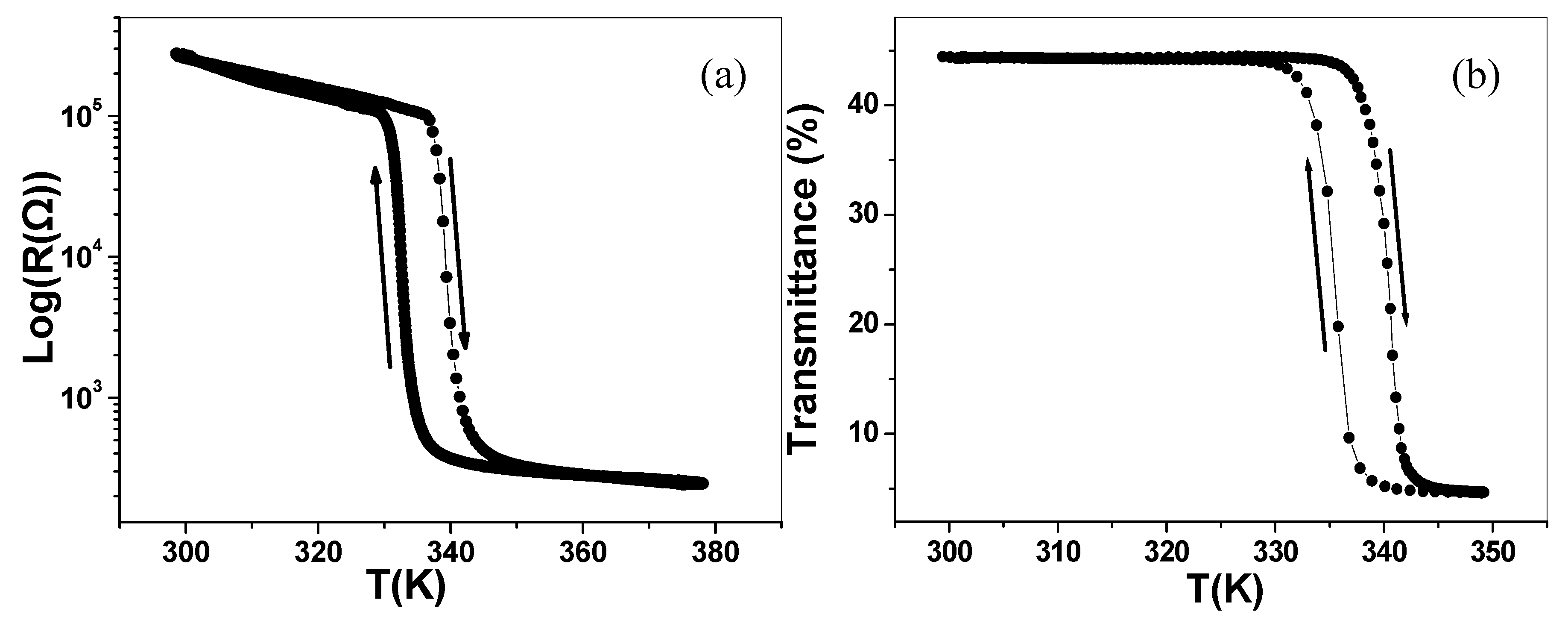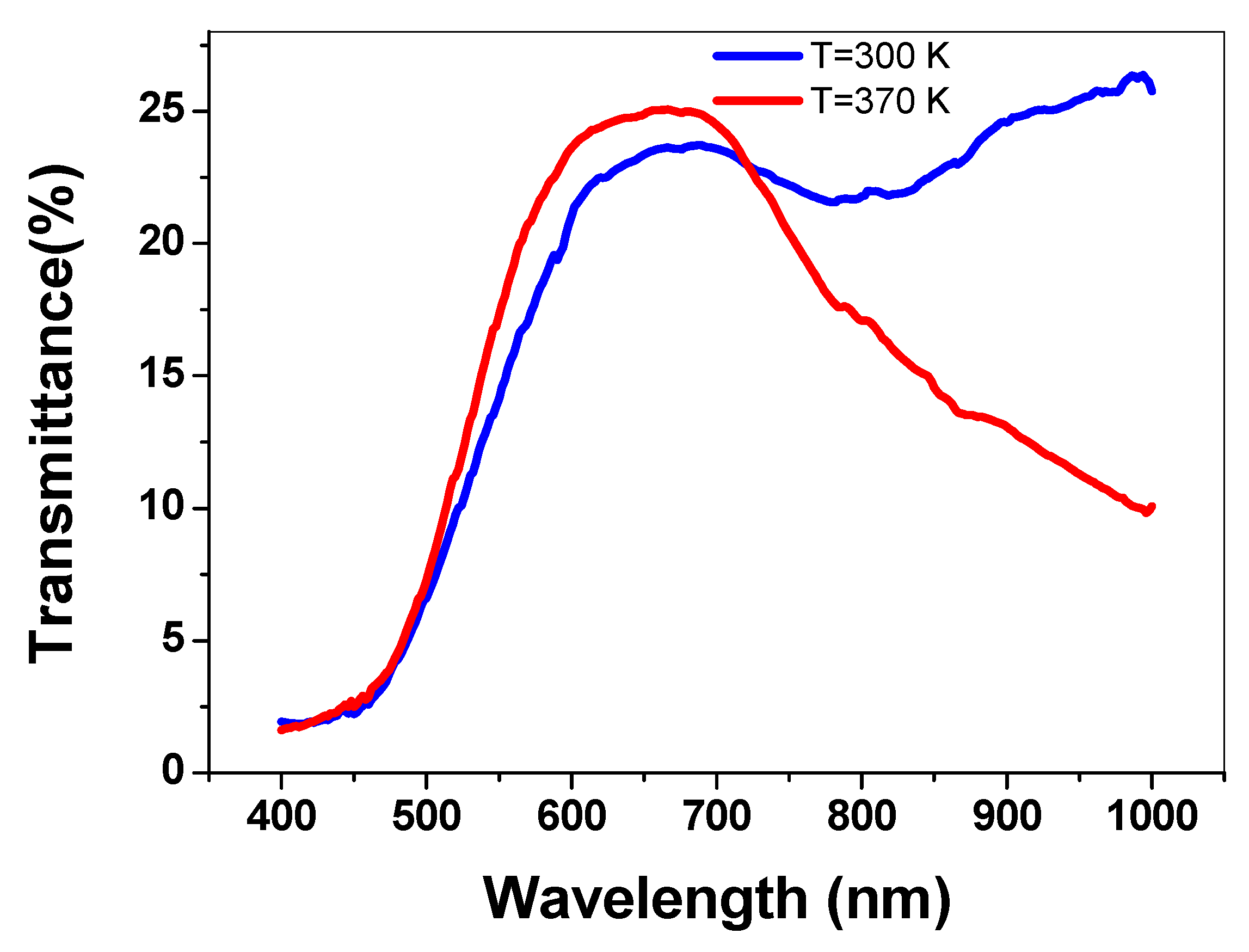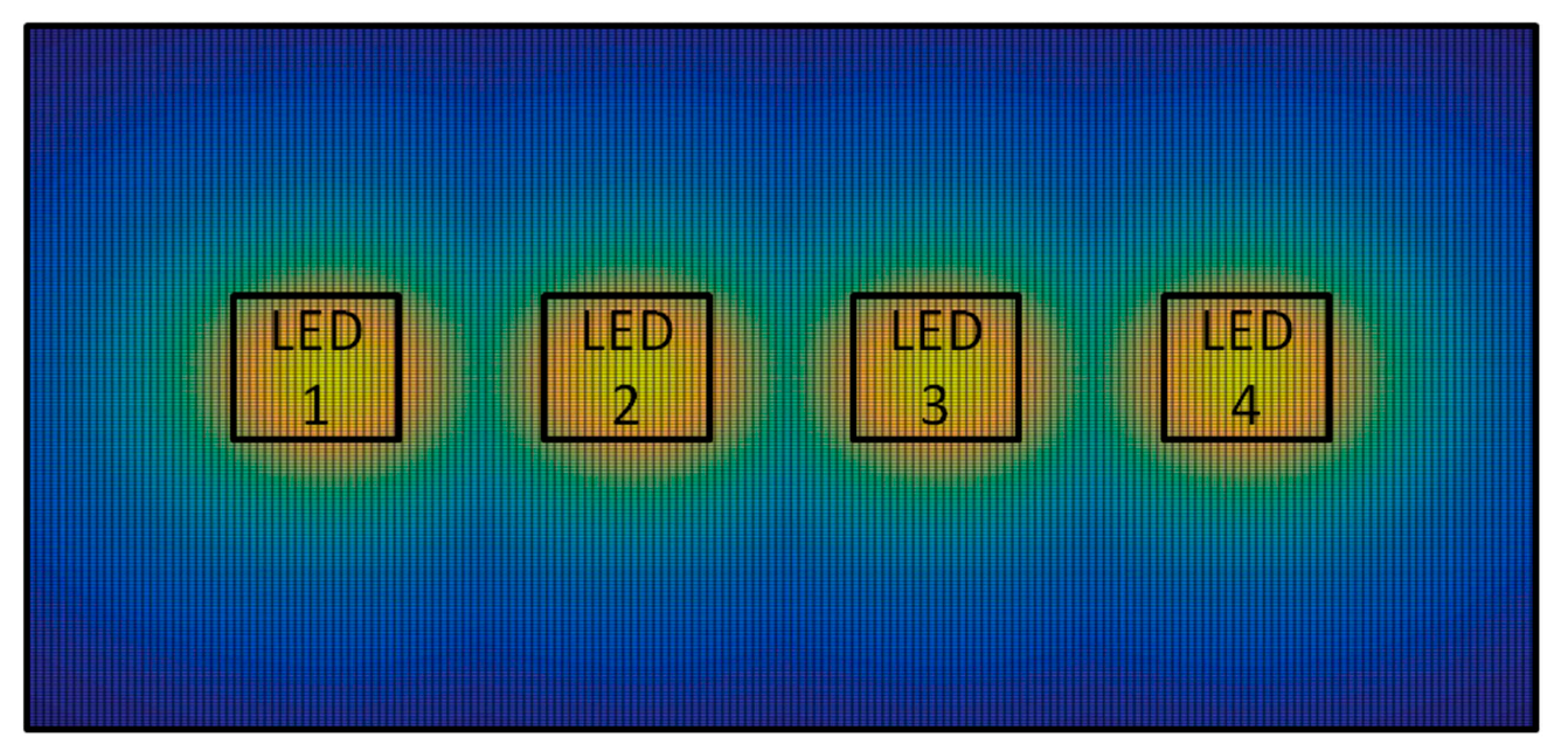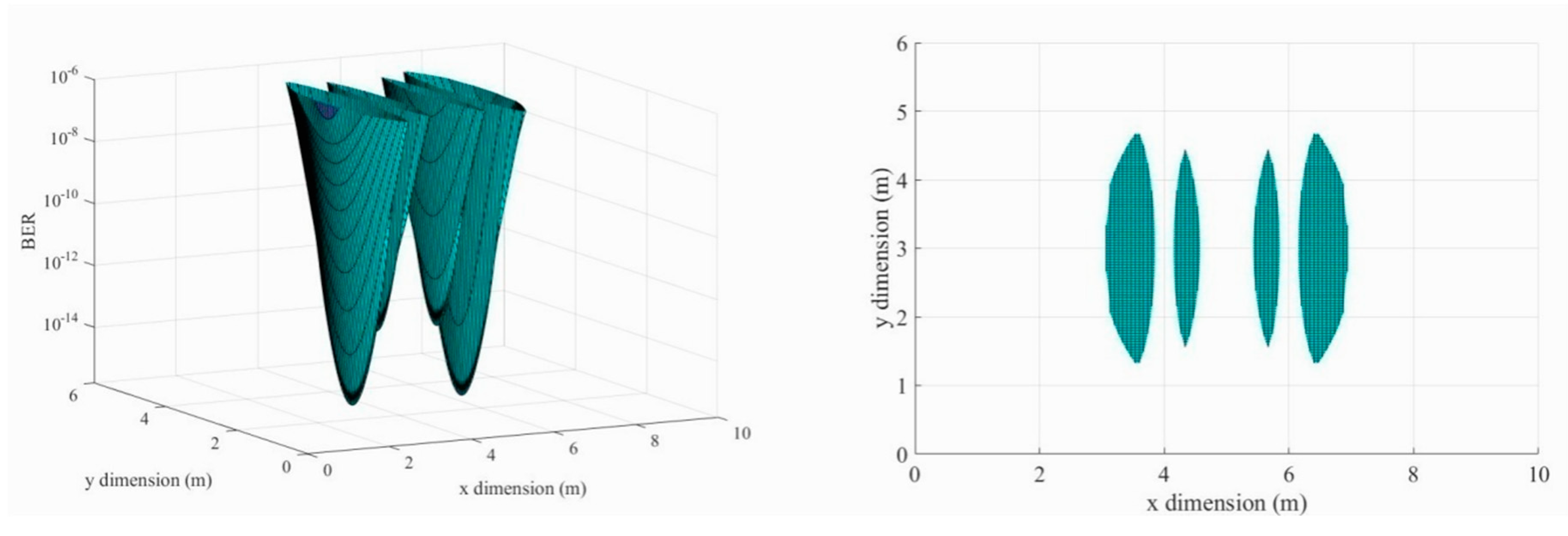Experimental Implementation and Theoretical Investigation of a Vanadium Dioxide Optical Filter for Bit Error Rate Enhancement of Enhanced Space Shift Keying Visible Light Communication Systems
Abstract
1. Introduction
2. Vanadium Dioxide Filter Elaboration Procedure
3. System Model
4. SNR Estimation
5. BER Estimation for eSSK
6. Numerical Results
7. Conclusions
Author Contributions
Funding
Conflicts of Interest
References
- Sivabalan, A.; John, J. Modeling and Simulation of Indoor Optical Wireless Channels: A Review. In Proceedings of the TENCON 2003, Conference on Convergent Technologies for Asia-Pacific Region, Bangalore, India, 15–17 October 2003; Volume 3, pp. 1082–1085. [Google Scholar] [CrossRef]
- Karunatilaka, D.; Zafar, F.; Kalavally, V.; Pathiban, R. LED Based Indoor Visible Light Communications: State of the Art. IEEE Commun. Surv. Tutor. 2015, 17, 1649–1678. [Google Scholar] [CrossRef]
- Medina, C.; Zambrano, M.; Navarro, K. Led Based Visible Light Communication: Technology, Applications and Challenges—A Survey. Int. J. Adv. Eng. Technol. 2015, 8, 482–495. [Google Scholar] [CrossRef]
- Lee, K.; Park, H.; Barry, J.R. Indoor Channel Characteristics for Visible Light Communications. IEEE Commun. Lett. 2011, 15, 217–219. [Google Scholar] [CrossRef]
- Fahamuel, P.; Thompson, J.; Haas, H. Performance analysis of indoor diffuse VLC MIMO channels using Angular Diversity Detectors. J. Lightwave Technol. 2016, 34, 1254–1266. [Google Scholar] [CrossRef]
- Ogunkoya, F.B.; Popoola, W.O.; Sinanović, S. Pilot-assisted PAPR reduction technique for O-OFDM using multiple LEDs in VLC systems. In Proceedings of the 2016 IEEE International Conference on Communications Workshops (ICC), Kuala Lumpur, Malaysia, 23–27 May 2016; pp. 309–314. [Google Scholar] [CrossRef]
- Nistazakis, H.E.; Stassinakis, A.N.; Muhammad, S.S.; Tombras, G.S. BER Estimation for Multi Hop RoFSO QAM or PSK OFDM Communication Systems Over Gamma Gamma or Exponentially Modeled Turbulence Channels. Elsevier Opt. Laser Technol. 2014, 64, 106–112. [Google Scholar] [CrossRef]
- Peppas, K.P.; Stassinakis, A.N.; Topalis, G.K.; Nistazakis, H.E.; Tombras, G.S. Average capacity of optical wireless communication systems over I-K atmospheric turbulence channels. IEEE/OSA J. Opt. Commun. Netw. 2012, 4, 1026–1032. [Google Scholar] [CrossRef]
- Linnartz, J.P.M.G.; Feri, L.; Yang, H.; Colak, S.B.; Schenk, T.C.W. Communications and Sensing of Illumination Contributions in a Power LED Lighting System. In Proceedings of the 2008 IEEE International Conference on Communications, Beijing, China, 19–23 May 2008; pp. 5396–5400. [Google Scholar] [CrossRef]
- Feng, L.; Hu, R.Q.; Wang, J.; Xu, P.; Qian, Y. Applying VLC in 5G Networks: Architectures and Key Technologies. IEEE Netw. 2016, 30, 77–83. [Google Scholar] [CrossRef]
- Wu, S.; Wang, H.; Youn, C. Visible light communications for 5G wireless networking systems: From fixed to mobile communications. IEEE Netw. 2014, 28, 41–45. [Google Scholar] [CrossRef]
- Leitgeb, E.; Plank, T.; Pezzei, P.; Ivanov, H.; Pérez-Jiménez, R. Optical Wireless Communications and Optical Sensing and Detection Technologies for Increasing the Reliability and Safety in Autonomous Driving Scenarios. In Proceedings of the 2018 20th International Conference on Transparent Optical Networks (ICTON), Bucharest, Romania, 1–5 July 2018; pp. 1–4. [Google Scholar] [CrossRef]
- Bekhrad, P.; Ivanov, H.; Leitgeb, E. Car to X Communication with Optical Wireless as Support and Alternative to RF-Technologies for Roads and Future Transportation. In Proceedings of the 2018 26th International Conference on Software, Telecommunications and Computer Networks (SoftCOM), Split, Croatia, 13–15 September 2018; pp. 1–6. [Google Scholar] [CrossRef]
- Kim, H.C.; Kim, B.W.; Jung, S.Y. Performance of a wavelength hopping MC-VPPM scheme for vehicle-to-infrastructure (V2I) VLC. Photonic Netw. Commun. 2017, 33, 60–68. [Google Scholar] [CrossRef]
- Manousou, D.K.; Stassinakis, A.N.; Syskakis, E.; Nistazakis, H.E.; Tombras, G.S.; Volos, C.K.; Tsigopoulos, A.D. Estimation of the influence of Vanadium Dioxide Optical Filters for the Performance of Visible Light Communication Systems. In Proceedings of the 2018 7th International Conference on Modern Circuits and Systems Technologies (MOCAST), Thessaloniki, Greece, 7–9 May 2018; pp. 1–4. [Google Scholar] [CrossRef]
- Ge, P.; Liang, X.; Wang, J.; Zhao, C. Optical Filters Design for Multi-Color Visible Light Communications. In Proceedings of the GLOBECOM 2017—2017 IEEE Global Communications Conference, Singapore, 4–8 December 2017; pp. 1–7. [Google Scholar] [CrossRef]
- Chung, Y.H.; Oh, S. Efficient optical filtering for outdoor visible light communications in the presence of sunlight or articifical light. In Proceedings of the 2013 International Symposium on Intelligent Signal Processing and Communication Systems, Naha, Japan, 12–15 November 2013; pp. 749–752. [Google Scholar] [CrossRef]
- Cao, X.; Jin, P. Solar Modulation Utilizing VO2-Based Thermochromic Coatings for Energy-Saving Applications. In Emerging Solar Energy Materials; IntechOpen: London, UK, 2018; Chapter 1. [Google Scholar] [CrossRef]
- Videv, S.; Haas, H. Practical space shift keying VLC system. In Proceedings of the 2014 IEEE Wireless Communications and Networking Conference (WCNC), Istanbul, Turkey, 6–9 April 2014; pp. 405–409. [Google Scholar] [CrossRef]
- Zhang, Q.; Bai, Z.; Zhang, N.; Sun, S.; Kwak, K.S. Performance Analysis of DC-SSK Scheme and Its Power Allocation in VLC System. In Proceedings of the 2018 International Conference on Computing, Networking and Communications (ICNC), Maui, HI, USA, 5–8 March 2018; pp. 280–284. [Google Scholar] [CrossRef]
- Popoola, W.; Sinanovic, S.; Nistazakis, H.E. Enhancing the Error Performance of Optical SSK under Correlated Channel Condition. In Proceedings of the 2016 IEEE International Conference on Communications Workshops (ICC), Kuala Lumpur, Malaysia, 23–27 May 2016; pp. 7–11. [Google Scholar] [CrossRef]
- Manganaris, K.N.; Nistazakis, H.E.; Stassinakis, A.N.; Tzanakaki, A.; Mkrttchian, G.; Tombras, G.S. Eight transmitter-short range indoor VLC system using spatial modulation technique of enhanced SSK with variable pulse width and correlated channel conditions. In Proceedings of the 7th International Conference on Experiments/Process/System Modeling/Simulation & Optimization, 7th IC-EPSMSO, Athens, Greece, 5–8 July 2017; pp. 141–148. [Google Scholar]
- Fan, L.L.; Chen, S.; Luo, Z.L.; Liu, Q.H.; Wu, Y.F.; Song, L.; Ji, D.X.; Wang, P.; Chu, W.S.; Gao, C.; et al. Strain Dynamics of Ultrathin VO2 Film Grown on TiO2 (001) and the Associated Phase Transition Modulation. Nano Lett. 2014, 14, 4036–4043. [Google Scholar] [CrossRef]
- Paik, H.; Moyer, J.A.; Spila, T.; Tashman, J.W.; Mundy, J.A.; Freeman, E.; Shukla, N.; Lapano, J.M.; Engel-Herbert, R.; Zander, W.; et al. Transport properties of ultra-thin VO2 films on (001) TiO2 grown by reactive molecular-beam epitaxy. Appl. Phys. Lett. 2015, 107, 163101. [Google Scholar] [CrossRef]
- Brown, B.L.; Lee, M.; Clem, P.G.; Nordquist, C.D.; Jordan, T.S.; Wolfley, S.L.; Leonhardt, D.; Edney, C.; Custer, J.A. Electrical and optical characterization of the metal-insulator transition temperature in Cr-doped VO2 thin films. J. Appl. Phys. 2013, 113, 173704. [Google Scholar] [CrossRef]
- Krammer, A.; Arnaud, M.; Vitale, W.A.; Mocny, P.; Jeanneret, P.; Guibert, E.; Whitlow, H.J.; Ionescu, A.M.; Schüler, A. Elevated transition temperature in Ge doped VO2 thin films. J. Appl. Phys. 2017, 122, 4045304. [Google Scholar] [CrossRef]
- Piccirillo, C.; Binions, R.; Parkin, I.P. Nb-Doped VO2 Thin Films Prepared by Aerosol-Assisted Chemical Vapour Deposition. Eur. J. Inorg. Chem. 2007, 2007, 4050–4055. [Google Scholar] [CrossRef]
- Dietrich, M.K.; Kyhl, F.; Polity, A.; Klar, P.J. Optimizing thermochromic VO2 by co-doping with W and Sr for smart window applications. Appl. Phys. Lett. 2017, 110, 141907. [Google Scholar] [CrossRef]
- Hanlon, T.J.; Coath, J.A.; Richardson, M.A. Molybdenum-doped vanadium dioxide coatings on glass produced by the aqueous sol-gel method. Thin Solid Films 2003, 436, 269–272. [Google Scholar] [CrossRef]
- Dietrich, M.K.; Kramn, B.G.; Becker, M.; Meyer, B.K.; Polity, A.; Klar, P.J. Influence of doping with alkanine earth metals on the optical properties of thermochromic VO2. J. Appl. Phys. 2015, 117, 185301. [Google Scholar] [CrossRef]
- Mlyuka, N.R.; Niklasson, G.A.; Granqvist, C.G. Mg doping of thermochromic VO2 films enhances the optical transmittance and the decrease the metal-insulator transition temperature. Appl. Phys. Lett. 2009, 95, 171909. [Google Scholar] [CrossRef]
- Liang, Z.; Zhao, L.; Meng, W.; Zhong, C.; Wei, S.; Dong, B.; Xu, Z.; Wan, L.; Wang, S. Tungsten-doped vanadium dioxide thin films as smart windows with self-cleaning and energy-saving functions. J. Alloys Compd. 2017, 694, 124–131. [Google Scholar] [CrossRef]
- Lulu, L.; Zhiming, W.; Chunhui, J.; Meizhen, S.; Haoqian, F.; Xueting, M.; Yadong, J. Effect of Fe doping on thermochromic properties of VO2 films. J. Mater. Sci. Mater. Electron. 2018, 29, 5501–5508. [Google Scholar] [CrossRef]
- Melnik, V.; Khatsevych, I.; Kladko, V.; Kuchuk, A.; Nikirin, V.; Romanyuk, B. Low-temperature method for thermochromic high ordered VO2 phase formation. Mater. Lett. 2012, 68, 215–217. [Google Scholar] [CrossRef]
- Lee, S.; Meyer, T.L.; Park, S.; Egami, T.; Lee, H.N. Growth control of the oxidation state in vanadium oxide thin films. Appl. Phys. Lett. 2014, 105, 223515. [Google Scholar] [CrossRef]
- Liu, X.; Wang, S.W.; Chen, F.; Yu, L.; Chen, X. Tuning phase transition temperature of VO2 thin films by annealing atmosphere. J. Phys. D Appl. Phys. 2015, 48, 265104. [Google Scholar] [CrossRef]
- Rampelberg, G.; Schutter, B.D.; Devulder, W.; Martens, K.; Radu, I.; Detavernier, C. In situ X-ray diffraction study of the controlled oxidation and reduction in the V–O system for the synthesis of VO2 and V2O3 thin films. J. Mater. Chem. C 2015, 3, 11357–11365. [Google Scholar] [CrossRef]
- Sun, Y.; Xiao, X.; Xu, G.; Dong, G.; Chai, G.; Zhang, H.; Liu, P.; Zhu, H.; Zhan, Y. Anisotropic vanadium dioxide sculptured thin films with superior thermochromic properties. Sci. Rep. 2013, 3, 2756. [Google Scholar] [CrossRef] [PubMed]
- Liu, G.H.; Deng, X.Y.; Wen, R. Electronic and optical properties of monoclinic and rutile vanadium dioxide. J. Mater. Sci. 2010, 45, 3270–3275. [Google Scholar] [CrossRef]
- Xiao, L.; Su, Y.; Qiu, W.; Ran, J.; Liu, Y.; Wu, J.; Lu, F.; Shao, F.; Peng, P. First-principles investigation on solar radiation shielding performance of rutile VO2 filters for smart windows. Appl. Phys. Lett. 2016, 109, 193906. [Google Scholar] [CrossRef]
- Takahashi, I.; Hibino, M.; Kudo, T. Thermochromic Properties of Double-Doped VO2 Thin Films Prepared by a Wet Coating Method Using Polyvanadate-Based Sols Containing W and Mo or W and Ti. Jpn. J. Appl. Phys. 2001, 40, 1391. [Google Scholar] [CrossRef]
- Gao, Y.; Wang, S.; Luo, H.; Dai, L.; Cao, C.; Liu, Y.; Chen, Z.; Kanehira, M. Enhanced chemical stability of VO2 nanoparticles by the formation of SiO2/VO2 core/shell structures and the application to transparent and flexible VO2-based composite foils with excellent thermochromic properties for solar heat control. Energy Environ. Sci. 2012, 5, 6104–6110. [Google Scholar] [CrossRef]
- Komine, T.; Nakagama, M. Fundamental Analysis for Visible-Light Communication System using LED Lights. IEEE Trans. Consum. Electron. 2004, 50, 100–107. [Google Scholar] [CrossRef]
- Menounou, S.; Stassinakis, A.N.; Nistazakis, H.E.; Tzanakaki, A.; Sandalidis, H.G.; Tombras, G.S. Study and simulation on performance of a VLC communication system. In Proceedings of the 7th International Conference on Experiments/Process/System Modeling/Simulation & Optimization, 7th IC-EPSMSO, Athens, Greece, 5–8 July 2017; Volume 2, pp. 457–464, ISBN 978-618-82173-3-1. [Google Scholar]
- Ndjiongue, A.R.; Ferreira, H.C.; Ngatched, T.M. Visible Light Communications (VLC) Technology. Wiley Encycl. Electr. Electron. Eng. 2015, 1–15. [Google Scholar] [CrossRef]
- De Lausnay, S.; De Strycker, L.; Goemaere, J.; Stevens, N.; Nauwelaers, B. Optical CDMA codes for an indoor localization system using VLC. In Proceedings of the 2014 3rd International Workshop in Optical Wireless Communications (IWOW), Funchal, Portugal, 17 September 2014; pp. 50–54. [Google Scholar] [CrossRef]
- Ab-Rahman, M.S.; Shuhaimi, N.I.; Azizan, L.A.H.; Hassan, M.R. Analytical Study of Signal-to-Noise Ratio for Visible Light Communication by Using Single Source. J. Comput. Sci. 2012, 8, 141–144. [Google Scholar] [CrossRef]
- Bekkali, A.; Naila, C.B.; Kazaura, K.; Wakamori, K.; Matsumoto, M. Transmission Analysis of OFDM-Based Wireless Services Over Turbulent Radio-on-FSO Links Modeled by Gamma-Gamma Distribution. IEEE Photonics J. 2010, 2, 510–520. [Google Scholar] [CrossRef]
- Wang, T.Q.; Sekercioglu, Y.A.; Armstrong, J. Analysis of An Optical Wireless Receiver Using a Hemispherical Lens with Application in MIMO Visible Light Communications. J. Lightwave Technol. 2013, 31, 1744–1754. [Google Scholar] [CrossRef]







| Parameter | Value |
|---|---|
| Transmitted Optical Power—Pt | 20 W |
| Semi-angle at half power—Φs | 35° |
| Receivers FOV | 70° |
| Physical Area of the receiver—A | 1 cm2 |
| Refractive index of the lens—nri | 1.5 |
| Absolute temperature of the room—Tk | 297 K |
| Photodetector’s capacitance—n | 1.12 μm−2 |
| Noise bandwidth factor I2 | 0.562 |
| Noise bandwidth factor I3 | 0.0868 |
| Noise Bandwidth—B | 175 MHz |
| Open loop voltage Gain—G | 10 |
| Channel noise factor—Γ | 1.5 |
| Transconductance—gm | 30 ms |
© 2019 by the authors. Licensee MDPI, Basel, Switzerland. This article is an open access article distributed under the terms and conditions of the Creative Commons Attribution (CC BY) license (http://creativecommons.org/licenses/by/4.0/).
Share and Cite
Manousou, D.K.; Stassinakis, A.N.; Syskakis, E.; Nistazakis, H.E.; Gardelis, S.; Tombras, G.S. Experimental Implementation and Theoretical Investigation of a Vanadium Dioxide Optical Filter for Bit Error Rate Enhancement of Enhanced Space Shift Keying Visible Light Communication Systems. Computation 2019, 7, 30. https://doi.org/10.3390/computation7020030
Manousou DK, Stassinakis AN, Syskakis E, Nistazakis HE, Gardelis S, Tombras GS. Experimental Implementation and Theoretical Investigation of a Vanadium Dioxide Optical Filter for Bit Error Rate Enhancement of Enhanced Space Shift Keying Visible Light Communication Systems. Computation. 2019; 7(2):30. https://doi.org/10.3390/computation7020030
Chicago/Turabian StyleManousou, Dimitra K., Argyris N. Stassinakis, Emmanuel Syskakis, Hector E. Nistazakis, Spiros Gardelis, and George S. Tombras. 2019. "Experimental Implementation and Theoretical Investigation of a Vanadium Dioxide Optical Filter for Bit Error Rate Enhancement of Enhanced Space Shift Keying Visible Light Communication Systems" Computation 7, no. 2: 30. https://doi.org/10.3390/computation7020030
APA StyleManousou, D. K., Stassinakis, A. N., Syskakis, E., Nistazakis, H. E., Gardelis, S., & Tombras, G. S. (2019). Experimental Implementation and Theoretical Investigation of a Vanadium Dioxide Optical Filter for Bit Error Rate Enhancement of Enhanced Space Shift Keying Visible Light Communication Systems. Computation, 7(2), 30. https://doi.org/10.3390/computation7020030







